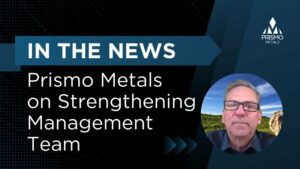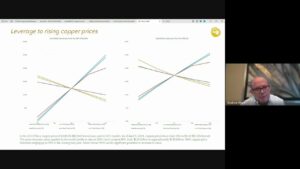Vancouver, British Columbia – Capstone Mining Corp. ("Capstone") (TSX: CS) today provided its operating and capital expenditure guidance for 2016 along with a five year outlook. In 2016, Capstone expects to produce 108,000 tonnes (±5%) of copper from its Pinto Valley, Cozamin and Minto mines at a C1 cash cost (1,2) of$1.45 to $1.55 per pound of payable copper produced. Capital expenditures for 2016, including $38 million of capitalized stripping, are expected to be $80.2 million or$0.35 per pound of copper produced. Consolidated all-in cost guidance is $1.90 to $2.00 per pound of payable copper produced. The subsequent four year outlook is included to illustrate the overall trend of our existing operations, excluding any further growth through project development or acquisition.
"In light of the current commodity price environment our 2016 guidance and five year outlook focuses on financial flexibility, while maximizing the cost efficiency of our existing operations," said Darren Pylot, Capstone President and CEO. "2016 is expected to be a strong year operationally for us as we process ore from the high grade Minto North open pit. We will further benefit from Cozamin's consistent performance and have started the year running well at Pinto Valley."
"Both our C1 cash cost and all-in cost are expected to be significantly lower in 2016, driven by higher production at each of our operations and strict capital management across the company," continued Mr. Pylot. "Our 2016 guidance reflects a number of cost reduction measures implemented and announced throughout 2015, including a reduction of our permanent workforce by 10% and full-time contractors by 5%. Additionally, moving into 2016 we have reduced corporate head office positions by 22%, budgeted a 25% reduction in general and administrative expenses and will immediately place the San Manuel Arizona Railroad Company("SMARRCO") on temporary care and maintenance."
2016 Copper Production and Cost Guidance
Pinto Valley | Cozamin | Minto | Total | |
Copper Production (tonnes ±5%) | 63,000 | 18,000 | 27,000 | 108,000 |
C1 Cash Cost (1,2) | $1.65-$1.75 | $1.35-$1.45 | $1.10-$1.20 | $1.45-$1.55 |
All-In Cost (1,3) | $2.00-$2.10 | $1.80-$1.90 | $1.30-$1.40 | $1.90-$2.00 |
Fully-Loaded All-In Cost (1,4) | $2.05-$2.15 | |||
(1) This is alternative performance measure; please see "Alternative Performance Measures" at the end of this release. (2) C1 cash cost per pound of payable copper produced net of by-product credits and selling costs. (3) All-In cost per pound of payable copper produced is C1 cash cost plus NSR and production royalties, non-cash deferred revenue, all sustaining capital expenditures (including exploration and production-phase capitalized stripping), accretion of reclamation obligations, amortization of reclamation assets, corporate G&A, share-based compensation, greenfield exploration, pre-production capitalized stripping, PV2 and PV3 development and Santo Domingo holding costs. (4) Fully-loaded All-In Cost is All-In Cost plus interest expense and taxes.
Pinto Valley: Throughout 2015 the mine began to see benefits from manpower reductions and cost efficiencies. C1 cash cost is expected to continue to fall as a result of increased throughput, declining input costs and targeted cost reduction activities which are continuing at the operation.
A key cost reduction initiative in 2016 is the temporary cessation of all rail operations as part of the transportation chain that delivers concentrate to the Port of Guaymas, Mexico for export. A modular truck transport system for both domestic consumption in the United States as well as to Guaymas for export will be used to haul the concentrate. SMARRCO will be placed on temporary care and maintenance, resulting in the furlough of 13 employees.
Cozamin: The focus in 2016 will be on cost reduction and operational efficiencies. The majority of the ore will continue to come from the San Roberto blocks in 2016, with the Mala Noche Footwall Zone contributing approximately 30% of ore production in 2016.
Minto: The 2016 production and operating costs at Minto reflect the significant contribution from the high grade Minto North open pit. Head grade is expected to average 1.3% in the first quarter, ramping up to over 2.6% in the second half of the year, resulting in significantly lower costs. Surface mining of the Minto North pit is expected to be completed in August 2016, with the mill continuing to process Minto North material until the end of Q1 2017.
Underground mining will be paused in Q1 2016 and the operation will be temporarily closed once all the ore from Minto North and the remaining stockpiles are processed by mid-2017. Future decisions will depend on a number of factors, most notably an improvement in the copper market outlook.
Copper Production and Costs 2017 to 2020: Consolidated production from 2017 to 2020 is expected to average between 70,000 and 85,000 tonnes of copper annually at a consolidated C1 cash cost ranging from $1.60 to $1.70 per pound of copper.
2016 Capital Expenditure Guidance – Operating Mines (US$M)
Pinto Valley | Cozamin | Minto | Total | |
Sustaining | $23.2 | $14.9 | $2.1 | $40.2 |
PV3 Development | 2.3 | – | – | 2.3 |
Capitalized Stripping * | 29.0 | – | 8.7 | 37.7 |
Total Capital | $54.5 | $14.9 | $10.8 | $80.2 |
* Capitalized stripping is included as an operating cost in the PV2 PFS and PV3 PFS, however, under IFRS accounting guidelines stripping costs are capitalized when the strip ratio is higher than the life-of-mine strip ratio.
Pinto Valley: The largest category of sustaining capital in 2016 is $10.3 million for mining fleet component replacement, which was accounted for as an operating cost prior to 2016 and in the PV2 PFS. In 2016 this has been reclassified from operating to capital and is accounted for as capital in the PV3 PFS.
Cozamin: Major capital expenditures in 2016 are $6.2 million for mine development and $3.5 million for the construction of a paste fill plant that was deferred from 2015.
Minto: Limited sustaining capital is required at Minto with the expected temporary closure in 2017.
Capital Expenditures 2017 to 2020: Beyond 2016 sustaining, development and brownfield exploration capital expenditures at our operating mines are expected to average $40 to $50 million annually (excluding capitalized stripping). Capitalized stripping at Pinto Valley from 2017 to 2020 is expected to range between $15 and $30 million annually.
2016 Exploration Program (US$M)
Brownfield | Greenfield | Total | ||
Cozamin | $2.9 | – | $2.9 | |
Project Providencia* – Chile | – | $5.5 | 5.5 | |
Total 2016 Budgeted Exploration Expenditures | $2.9 | $5.5 | $8.4 | |
* Exploration is expected to be expensed for Project Providencia.
Brownfield Exploration: At Cozamin, the 2016 exploration program includes 10,400 metres of primarily underground infill and step-out drilling aimed at increasing reserves, primarily in the Mala Noche Vein and Mala Noche Footwall Zone.
Greenfield Exploration: In 2016 greenfield exploration is principally focused on Project Providencia in Chile, Capstone's earn-in project with Sociedad Química yMinera de Chile S.A. ("SQM"), with a continuation of the geophysics, geochemistry and drill programs that began in 2014. There is no minimum expenditure commitment in 2016 under the SQM agreement and as exploration activities are discretionary, we will align our expenditures with prevailing market conditions, financing capacity and corporate priorities.
The guidance represents the base case 2016 exploration program, which includes advancing towards scoping level resource estimates on two of the three copper discoveries at Project Providencia since 2014, along with commencing basic metallurgical studies. One deposit is a completely oxidized Chilean Stratabound Type and the other is a deeply oxidized IOCG Type. In both cases mineralization is at or very near surface, covered by very shallow overburden. Drilling in 2016 will focus on the near surface copper oxide potential.
About Capstone Mining Corp.
Capstone Mining Corp. is a Canadian base metals mining company, focused on copper. We are committed to the responsible development of our assets and the environments in which we operate. Our three producing mines are the Pinto Valley copper mine located in Arizona, US, the Cozamin copper-silver mine in Zacatecas State, Mexico and the Minto copper mine in Yukon, Canada. In addition, Capstone has two copper development projects; the large scale 70% owned copper-ironSanto Domingo project in Region III, Chile, in partnership with Korea Resources Corporation, and the 100% owned copper-zinc Kutcho project in British Columbia, Canada, as well as exploration properties in Chile. Capstone's strategy is to extend the lives of our current mines with mineral resource and reserve expansions, maintain optionality on the Santo Domingo development project, prudently progress the exploration portfolio and grow through acquisitions in politically stable, mining-friendly regions. We will pace our growth with our financial capacity, ensuring we retain, as a priority, sufficient financial flexibility to meet the requirements of our existing operations and our committed development projects, while maintaining an adequate cushion to deal with market volatility and operating risks inherent in the mining industry. Our headquarters are in Vancouver, Canada and we are listed on the Toronto Stock Exchange (TSX). Further information is available atwww.capstonemining.com.
Cautionary Note Regarding Forward-Looking Information
This document may contain "forward-looking information" within the meaning of Canadian securities legislation and "forward-looking statements" within the meaning of the United States Private Securities Litigation Reform Act of 1995 (collectively, "forward-looking statements"). These forward-looking statements are made as of the date of this document and Capstone Mining Corp. (the "Company") does not intend, and does not assume any obligation, to update these forward-looking statements, except as required under applicable securities legislation.
Forward-looking statements relate to future events or future performance and reflect Company management's expectations or beliefs regarding future events and include, but are not limited to, statements with respect to the estimation of mineral reserves and mineral resources, the conversion of mineral resources to mineral reserves, the realization of mineral reserve estimates, the timing and amount of estimated future production, costs of production, capital expenditures, success of mining operations, environmental risks, unanticipated reclamation expenses, title disputes or claims and limitations on insurance coverage. In certain cases, forward-looking statements can be identified by the use of words such as "plans", "expects" or "does not expect", "is expected", "outlook", "budget", "scheduled", "estimates", "forecasts", "intends", "anticipates" or "does not anticipate", or "believes", or variations of such words and phrases or statements that certain actions, events or results "may", "could", "would", "might" or "will be taken", "occur" or "be achieved" or the negative of these terms or comparable terminology. In this document certain forward-looking statements are identified by words including "anticipated", "guidance", "plan", "estimated" and "expected". By their very nature forward-looking statements involve known and unknown risks, uncertainties and other factors which may cause the actual results, performance or achievements of the Company to be materially different from any future results, performance or achievements expressed or implied by the forward-looking statements. Such factors include, among others, risks related to actual results of current exploration activities; changes in project parameters as plans continue to be refined; future prices of mineral resources; possible variations in ore reserves, grade or recovery rates; accidents; dependence on key personnel; labour pool constraints; labour disputes; availability of infrastructure required for the development of mining projects; delays in obtaining governmental approvals or financing or in the completion of development or construction activities; counterparty risks associated with sales of our metals; changes in general economic conditions; increased operating and capital costs; operating in foreign jurisdictions with risk of changes to governmental regulation; impact of climatic conditions on our Pinto Valley, Cozamin and Mintooperations; increasing energy prices; our ability to integrate new acquisitions into our operations, and other risks of the mining industry as well as those factors detailed from time to time in the Company's interim and annual financial statements and management's discussion and analysis of those statements, all of which are filed and available for review on SEDAR at www.sedar.com. Although the Company has attempted to identify important factors that could cause actual actions, events or results to differ materially from those described in forward-looking statements, there may be other factors that cause actions, events or results not to be as anticipated, estimated or intended. There can be no assurance that forward-looking statements will prove to be accurate, as actual results and future events could differ materially from those anticipated in such statements. Accordingly, readers should not place undue reliance on forward looking statements.
National Instrument 43-101 Compliance
Unless otherwise indicated, Capstone has prepared the technical information in this news release ("Technical Information") based on information contained in the technical reports, news releases and MD&A's (collectively the "Disclosure Documents") available under Capstone Mining Corp.'s company profile on SEDAR atwww.sedar.com. Each Disclosure Document was prepared by, or under the supervision of, a qualified person (a "Qualified Person") as defined in National Instrument 43-101 Standards of Disclosure for Mineral Projects of the Canadian Securities Administrators ("NI 43-101"). Readers are encouraged to review the full text of the Disclosure Documents which qualifies the Technical Information. Readers are advised that mineral resources that are not mineral reserves do not have demonstrated economic viability. The Disclosure Documents are each intended to be read as a whole, and sections should not be read or relied upon out of context. The Technical Information is subject to the assumptions and qualifications contained in the Disclosure Documents.
The technical information in this news release ("Technical Information") was prepared by, or under the supervision of, a qualified person (a "Qualified Person") as defined in National Instrument 43-101 Standards of Disclosure for Mineral Projects of the Canadian Securities Administrators ("NI 43-101"). The disclosure of the Technical Information contained in this news release has been reviewed and approved by Gregg Bush, P. Eng., Senior Vice President and Chief Operating Officer. Technical Information related to mineral exploration activities has been reviewed and approved by Brad Mercer, P. Geol., Senior Vice President, Exploration. Both are Qualified Persons under NI 43-101.
Alternative Performance Measures
The items marked with a "(1), (2), (3), (4)" are alternative performance measures and readers should refer to Alternative Performance Measures in the Company's Consolidated Interim Management's Discussion and Analysis for the quarter ended September 30, 2015 as filed on SEDAR and as available on the Company's website.
Cautionary Note to United States Investors
This news release contains disclosure that has been prepared in accordance with the requirements of Canadian securities laws, which differ from the requirements of U.S. securities laws. Without limiting the foregoing, this news release may refer to technical reports that use the terms "indicated" and "inferred" resources. U.S. investors are cautioned that, while such terms are recognized and required by Canadian securities laws, the SEC does not recognize them. Under U.S. standards, mineralization may not be classified as a "reserve" unless the determination has been made that the mineralization could be economically and legally produced or extracted at the time the reserve determination is made. U.S. investors are cautioned not to assume that all or any part of indicated resources will ever be converted into reserves. U.S. investors should also understand that "inferred resources" have a great amount of uncertainty as to their existence and as to whether they can be mined legally or economically. It cannot be assumed that all or any part of "inferred resources" will ever be upgraded to a higher category. Therefore, U.S. investors are also cautioned not to assume that all or any part of inferred resources exist, or that they can be mined legally or economically. Accordingly, information concerning descriptions of mineralization and resources contained in this news release may not be comparable to information made public by U.S. companies subject to the reporting and disclosure requirements of the SEC.
 604-637-8157, [email protected]
604-637-8157, [email protected]























